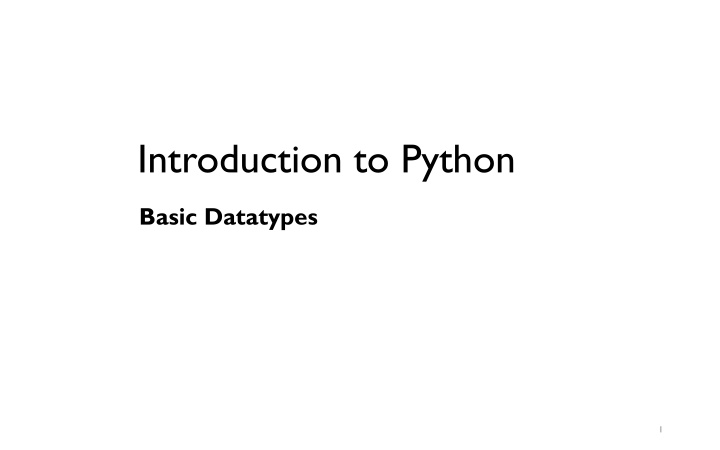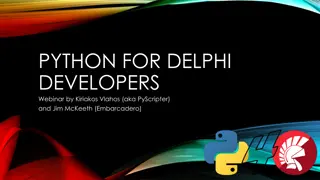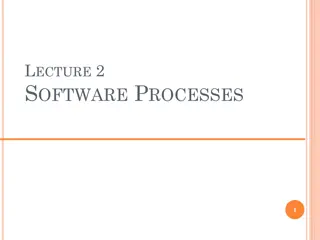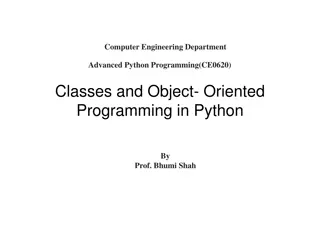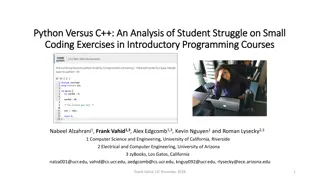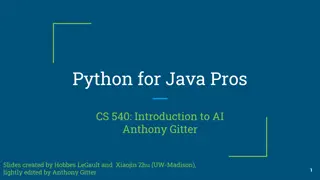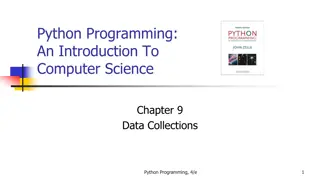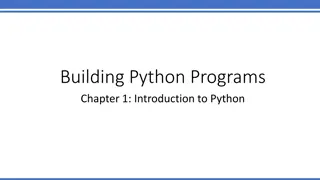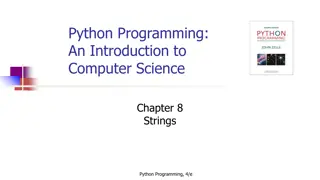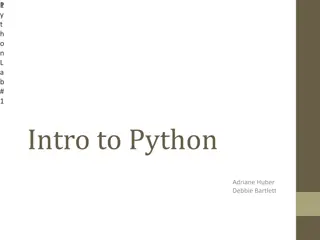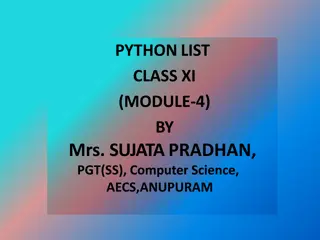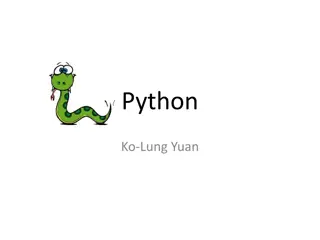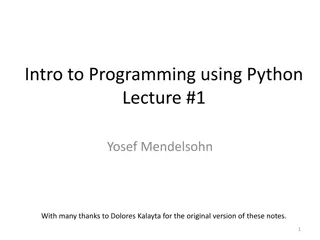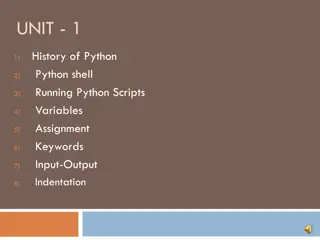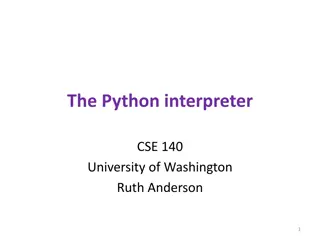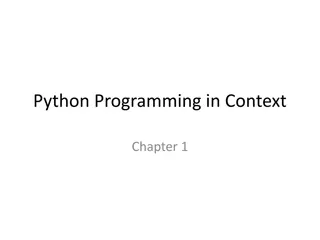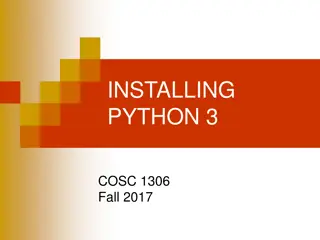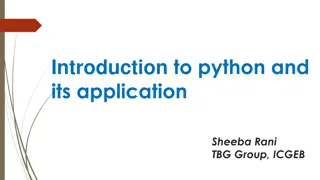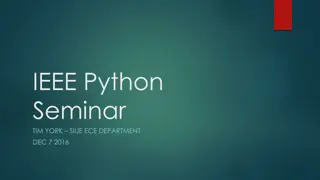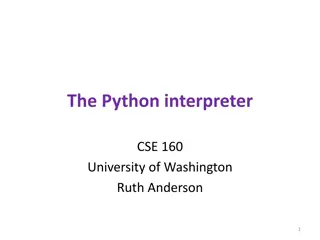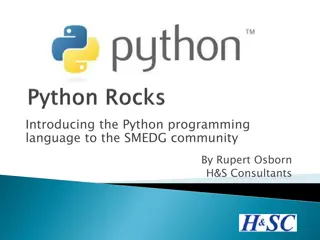Introduction to Basic Python Datatypes & Software Development
Explore the fundamental concepts of Python programming, including basic datatypes such as integers, floats, and booleans. Learn about software development, Python scripts, printing messages, user inputs, and more. Get started with Python using online IDEs like repl.it and delve into writing your first program. Understand how to use the print function, manage newlines, and evaluate math expressions.
Download Presentation

Please find below an Image/Link to download the presentation.
The content on the website is provided AS IS for your information and personal use only. It may not be sold, licensed, or shared on other websites without obtaining consent from the author.If you encounter any issues during the download, it is possible that the publisher has removed the file from their server.
You are allowed to download the files provided on this website for personal or commercial use, subject to the condition that they are used lawfully. All files are the property of their respective owners.
The content on the website is provided AS IS for your information and personal use only. It may not be sold, licensed, or shared on other websites without obtaining consent from the author.
E N D
Presentation Transcript
Introduction to Python Basic Datatypes 1
Topics 1) Software, Python Scripts 2) replit 3) Printing with print() 4) Basic Built-In Number Types a) Integers b) Floats c) Booleans 5) Casting 6) User inputs 2
Software A programis a collection of program statements that performs a specific task when run by a computer. A program is often referred to as software. A program can be written in many programming languages. We will be using Python in this course. By convention, Python code is stored in a file called a script with a .py extension. Scripts are written using an IDE(Integrated Development Environment). We will initially use an online IDE (repl.it, login with your Google account) to learn the basics of Python. A popular IDE that can be installed locally on your computer is Visual Studio Code. 3
Python Scripts repl.it: Create a new repl and pick Python as the language, name the repl. print("Hello, World!") Type in the code in the file main.py. Click on run. 4
Our First Program 1) The print() function prints messages on the console. 2) Characters enclosed in quotes(single or double) forms a literal string. print("Hello, World!") 3) The console output string does not include the quotes. 5
By default, print() will end each output with a newline character. A newline character is a special control character used to indicate the end of a line. print() print("hello") print("Mike") print() print("line1\nline2\nline3") In a string literal, '\n' denote a newline character. Output: hello Mike empty line line1 line2 line3 6
print() print("hello") print(4) print(3.14) print(3 + 4) Note: The console output string does not include the quotes. Output: hello 4 3.14 7 print() will evaluate math expressions before printing. 7
print() The print function can accept any number of positional arguments, including zero, one, or more arguments. Arguments are separated by commas. This is useful when you d want to join a few elements together(e.g. strings, numbers, math expressions, etc ). print() concatenated all arguments passed to it, and it inserted a single space between them. print("I have", 3, "apples.") print("You have", 3+2, "apples.") Output: I have 3 apples. You have 5 apples. 8
Dynamic Typing Python is dynamically typed: variable names can point to objects of any type. Unlike Java or C, there is no need to declare the variable. x = 1 x = hello # x is an integer # now x is a string Commentsare a form of program documentation written into the program to be read by people and do not affect how a program runs. Python uses # for comments. 9
Variables We can use variables to refer to values that can be used later. You can create a new variable by given it a value. x = 4 print(x) # 4 Variable names can use letters, digits, and the underscore symbol (but they can t start with a digit). It is considered best practice to use meaningful variable names: num_apples = 10 num_oranges = 5 total = num_apples + num_oranges 10
= is not equality Unlike in math, = is not equality in Python. It is an assignment: assign the expression on the right side of = to the variable on the left. x = 4 x = x + 1 # evaluate right side, assigns to left side variable print(x) # 5 # in math, this has no solutions! Assignment is not symmetric. x = 4 # correct! 10 = y # error! 11
Try It 1.1 See JuiceMind lesson Basic Datatypes for this Try It lab. Fill in the code as instructed below. x = 5 # Use one print statement to print "I have 5 apples.". # You must use the x variable above. # Use one print statement to print "I have 7 apples." # Use the x variable again in your code. 12
Try It 1.2 See JuiceMind lesson Basic Datatypes for this Try It lab. Fill in the code to match the output below. You must use the points variable in your code. Write exactly FOUR lines of code for this problem. points = 3 # update the variable points by multiplying it by 2 # then print out "You got a star! Your score is doubled to 6". Use the points variable in your code. # update the variable points by multiplying it by 3 # then print out "You got a coin! Your score is tripled to 18". Use the points variable in your code. 13
Basic Built-In Types In this lecture, we'll focus on integers, floating-point numbers, strings and boolean values. 14
Integers The most basic numerical type is the integer. Any number without a decimal point is an integer. Python integers are variable-precision, so you can do computations that would overflow in other languages. x = 1 y = 2 ** 200 print("x:", x) print("y:", y) Output: x: 1 y: 1606938044258990275541962092341162602522202993782792835301376 15
Floating Point The floating-point type can store fractional numbers(i.e. real numbers). x = 0.5 print(x) # 0.5 y = 2.3451 print(y) # 2.3451 16
Boolean Type The Boolean type is a simple type with two possible values: True and False. Boolean values are case-sensitive: unlike some other languages, True and False must be capitalized! Comparison operators return True or False values. result = (4 < 5) print(result) print(3 >= 5) print(3 != 5) print(3 == 5) # True # False # True # False 17
Strings In Python, text is represented as a string, which is a sequence of characters (letters, digits, and symbols). We indicate that a value is a string by putting either single or double quotes around it. p1 = "Aristotle" p2 = 'Isaac Newton' Whenever you create a string by surrounding text with quotation marks, the string is called a string literal. The name indicates that the string is literally written out in your code. You can use + operator to concatenate two strings. a = "Isaac" b = "Newton" name = a + + b # Isaac Newton 18
Casting The int(), float() and str() functions can be called to cast a value to an integer, float, or string respectively. x = 1.8 y = int("3") z = float("3") # String is casted to a float. w = int(x) # float is casted to an integer(truncates), 1 v = str(x) # float is casted to string "1.8 print(z) # 3.0 print(w) # 1, decimal is truncated. # String is casted to an integer. 19
Program Inputs Program input is data sent to a computer for processing by a program. Input can come in a variety of forms such as: tactile(swipes from a tablet) audio(input can be an audio/voice to be processed by a program) visual(an image to be filtered by a program) text(user input from keyboard or can be a text file input) Program outputs are any data sent from a program to a device. Program output can come in a variety of forms, such as tactile, audio, visual, or text. 20
Program Inputs A program is useful if it takes some input from the user, process it and outputs something meaningful. We will start with a simple program that accepts user inputs from the keyboard and outputs some result by printing it on the console. The input function input() can be used to accept inputs from the user. 21
Input Programs may use the input function input() to obtain information from the user. The program waits for the user to enter some input. The inputted value can be stored in a variable once the user presses Enter. print('Please enter some text:') x = input() print('You entered:', x) print('Type:', type(x)) The type() function allows you to see the datatype of a variable. Note that user input is always a string. Please enter some text: 123 You entered: 123 Type: <class 'str'> The variable x stores the string literal "123". (x belongs to the string(str) class) x is not the integer 123! 22
Input Since user input almost always requires a message to the user about the expected input, the input function optionally accepts a string that it prints just before the program stops to wait for the user to respond. x = input('Please enter an integer value: ') y = input('Please enter another integer value: ') x = int(x) # casts to an integer y = int(y) # casts to an integer print(x, '+', y, '=', x+y) Please enter an integer value: 4 Please enter another integer value: 5 4 + 5 = 9 23
Input Or even more succinctly. x = int(input( Please enter an integer value: )) y = int(input('Please enter another integer value: )) print(x, '+', y, '=', x+y) Please enter an integer value: 4 Please enter another integer value: 5 4 + 5 = 9 24
Functions Throughout this lecture, we were introduced to many functions: print(), int(),float(), str(), type() and input(). These functions are no different than functions you have seen in your math class. Understanding this will help you call functions correctly with the right syntax. If you have a function in math ? ? = ?2. Then the value of ?(3) is 9. Similarly, in Python, for the int() function, the value of int(4.5) is 4. The value of the variable x below has the value of 3.0: x = float("3") If? ? = 3?then the function composition ?(? 2 )has the value 36. Similarly, the value of the function composition int(float("3.2") is 3. Another example of function composition we saw earlier: x = int(input( Please enter an integer value: )) 25
AP Exam Info The AP Exam does not mandate a particular language for APCS Principles. AP Exam questions will use a language-agnostic syntax to test programming questions. Syntax on the AP Exam can either be in "text" format or "block" format. The assignment operator on the AP Exam will use an arrow notation instead of the = in Python. In addition, the print() function is replaced by the display() function. 26
AP Exam Info 27
Lab 1: Using Variables Create a new repl on repl.it. Write code to match the following console output: Enter your name: Mike Hello Mike Enter an integer: 10 Your number 10 doubled is 20 The next number after 10 is 11 28
References 1) Vanderplas, Jake, A Whirlwind Tour of Python, O reilly Media. This book is completely free and can be downloaded online at O reilly s site. 29
